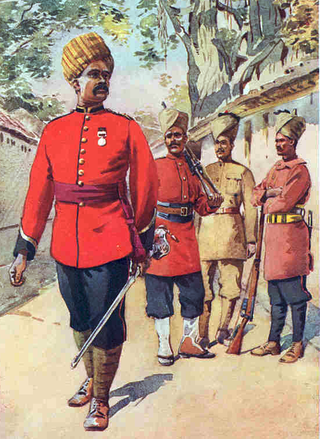Related Research Articles

The 1st Punjab Regiment was an infantry regiment of the British Indian Army from 1922 to 1947. Upon the Partition of India, it was transferred to the newly-raised Pakistan Army. It ceased to exist in this form in 1956, when it was amalgamated with the 14th, 15th and 16th Punjab regiments to form the Punjab Regiment, an existing infantry regiment of the Pakistan Army.

The 66th Punjabis was an infantry regiment of the British Indian Army. It was raised in 1761 as the 7th Battalion of Coast Sepoys. It was designated as the 66th Punjabis in 1903 and became 2nd Battalion 1st Punjab Regiment in 1922. In 1947, it was allocated to the Pakistan Army, where it continues to exist as 2nd Battalion The Punjab Regiment.

The 76th Punjabis was an infantry regiment of the British Indian Army. It was raised by Captain Thomas Lane at Trichonopoly on 16 December 1776, as the 16th Carnatic Battalion. It was designated as the 76th Punjabis in 1903 and became the 3rd Battalion 1st Punjab Regiment in 1922. In 1947, it was allocated to the Pakistan Army, where it continues to exist as 3rd Battalion The Punjab Regiment.
The 64th Pioneers was a regiment of the British Indian Army. Originally serving as regular infantry it evolved into a specialist military pioneer unit performing engineering and construction tasks.
The 79th Carnatic Infantry was an infantry regiment of the British Indian Army. They could trace their origins to 1777, when the 20th Carnatic Battalion was raised from sub-units of the 1st, 3rd, 8th and 16th Carnatic Battalions.

The 61st Pioneers were an infantry regiment of the British Indian Army. They trace their origins to 1758, when they were raised as the 1st Battalion Coast Sepoys.

The 63rd Palamcottah Light Infantry was an infantry regiment of the British Indian Army. The regiment could trace its origins to 1759, when it was raised as the 4th Battalion Coast Sepoys.
The 67th Punjabis were an infantry regiment of the British Indian Army. They could trace their origins to 1759, when they were raised as the 8th Battalion Coast Sepoys.
The 69th Punjabis were an infantry regiment of the British Indian Army. They could trace their origins to 1759, when they were raised as the 10th Battalion Coast Sepoys.
The 72nd Punjabis were an infantry regiment of the British Indian Army. They could trace their origins to 1759, when they were raised as the 16th Battalion Coast Sepoys.

The 73rd Carnatic Infantry was an infantry regiment originally raised in 1776 as the 13th Carnatic Battalion as part of the Presidency of Madras Army which was itself part of the Honourable East India Company Army. The presidency armies, like the presidencies themselves, belonged to the East India Company until the Government of India Act 1858 transferred all three presidencies to the direct authority of the British Crown. In 1903 all three presidency armies were merged into the British Indian Army. The unit was transferred to the Indian Army upon Indian Independence.
The 74th Punjabis were an infantry regiment of the British Indian Army. They could trace their origins to 1776, when they were raised as the 14th Carnatic Battalion.
The 75th Carnatic Infantry were an infantry regiment of the British Indian Army. They could trace their origins to 1776, when they were raised as the 15th Carnatic Battalion by enlisting men from the 2nd, 6th and 12th Carnatic Battalions.
The 80th Carnatic Infantry were an infantry regiment of the British Indian Army. They could trace their origins to 1777, when they were raised as the 21st Carnatic Battalion, by enlisting men from the 2nd, the 6th, the 12th and the 15th Carnatic Battalions.
The 81st Pioneers were an infantry regiment of the British Indian Army. They could trace their origins to 1786, when they were raised as the 28th Madras Battalion.
The 86th Carnatic Infantry was an infantry regiment originally raised in 1794 as the 36th Madras Native Infantry, part of the Presidency of Madras Army which was itself part of the Honourable East India Company Army. The presidency armies, like the presidencies themselves, belonged to the East India Company until the Government of India Act 1858 transferred all three presidencies to the direct authority of the British Crown. In 1903 all three presidency armies were merged into the British Indian Army. The unit was disbanded before Indian Independence.
The 87th Punjabis were an infantry regiment of the British Indian Army. They could trace their origins to 1798, when they were raised as the 1st Battalion, 14th Madras Native Infantry.

The 114th Mahrattas were an infantry regiment of the British Indian Army. The regiment traces their origins to 1800, when they were raised as the 2nd Battalion, 7th Regiment of Bombay Native Infantry.
The 128th Pioneers were an infantry regiment of the British Indian Army. The regiment traces their origins to 1846, when they were raised as the 28th Bombay Native Infantry.
The 77th Moplah Rifles were an infantry regiment of the British Indian Army. They could trace their origins to 1777, when they were raised as the 17th Carnatic Battalion.
References
- ↑ Sharma, p.52
- ↑ "Army reductions". Parliamentary Debates (Hansard) . 13 April 1921. Retrieved 28 September 2009.
- ↑ Sumner p.15
- Barthorp, Michael; Burn, Jeffrey (1979). Indian infantry regiments 1860–1914. Osprey Publishing. ISBN 0-85045-307-0.
- Rinaldi, Richard A (2008). Order of Battle British Army 1914. Ravi Rikhye. ISBN 978-0-9776072-8-0.
- Sharma, Gautam (1990). Valour and sacrifice: famous regiments of the Indian Army. Allied Publishers. ISBN 81-7023-140-X.
- Sumner, Ian (2001). The Indian Army 1914–1947. Osprey Publishing. ISBN 1-84176-196-6.
- Moberly, F.J. (1923). Official History of the War: Mesopotamia Campaign, Imperial War Museum. ISBN 1-870423-30-5